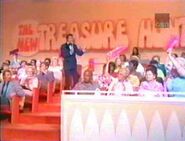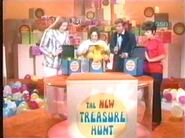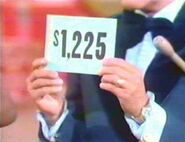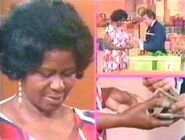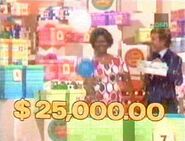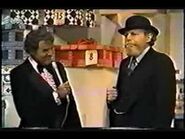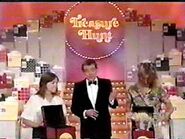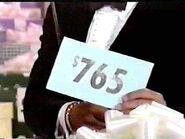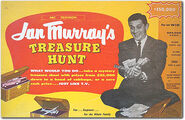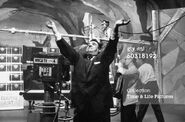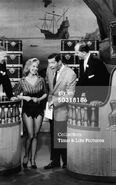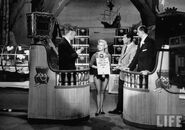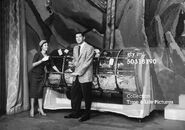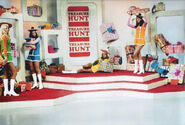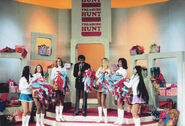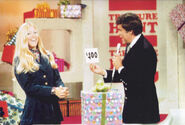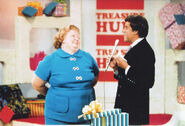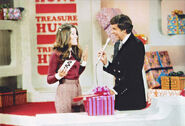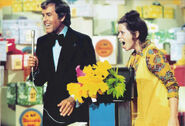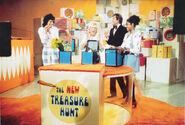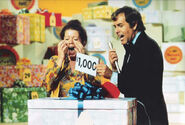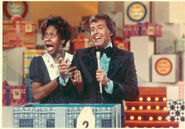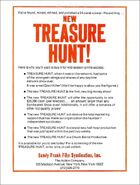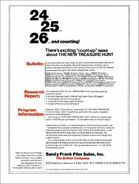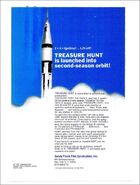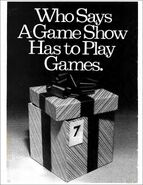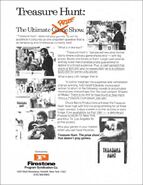| Hosts | |
| Jan Murray (1956–1959) Bob Kennedy (sub) Geoff Edwards (1972–1982) | |
| Models | |
| "Pirate Girls" Greta Thyssen & Pat White (1956–1959) Sivi Aberg, Jane Nelson, Naomi DeVargas, Pamela Hensley & Tanya Morgan (1973–1977) Jan Speck (1981–1982) | |
| Announcers | |
| Tom Reddy, Bill Wendell, Bob Williams, Carl King (1956–1959) Johnny Jacobs (1972–1981) Tony McClay (1982) | |
| Broadcast | |
| ABC Primetime: 9/7/1956 – 5/31/1957 NBC Daytime: 8/12/1957 – 12/4/1959 NBC Primetime: 12/24/1957 – 6/17/1958Pilot: 10/15/1972 Syndication (Weekly): 9/10/1973 – 9/11/1977Syndication (Daily): 9/14/1981 – 3/12/1982 (reruns aired until 9/1982) | |
| Packagers | |
| Jantone Productions/Screen Gems Television (1956–1959) Chuck Barris Productions (1972–1982) | |
| Distributors | |
| Sandy Frank Film Syndication (1973–1977) Firestone Syndication Services (1981–1982) | |
1950s intro:
"In front of you is a curtain. Behind that curtain are treasures, fantastic treasures worth over $50,000. The American/National Broadcasting Company is proud to present Treasure Hunt! And now, here's the star of our show, JAN MURRAY!"
1972 Pilot Intro:
"Ladies and gentlemen, this mystery celebrity, witnessed by this Lloyds of London bonded agent, has just placed a $25,000 check in one of these surprise packages. Tonight, six contestants will compete for thousands of dollars in prizes, in the chance of winning that $25,000 grand prize, on…TREASURE HUNT! And now, please meet your host, the star of Treasure Hunt, the incomparable, the magnificent, the one and only GEOFF EDWARDS!"
70s/80s Intro:
"Ladies and gentlemen, this bonded security agent has just placed a certified check for $25,000/(insert jackpot check amount) in one of these 30/66 surprise packages. Today/Tonight, someone may win a fortune in/any one of our fabulous prizes, or that grand prize of $25,000/(insert jackpot check amount), on… (THE NEW) TREASURE HUNT! From Hollywood, it's (The New) Treasure Hunt! And here's the (host, the) star of our show, GEOFF EDWARDS!"
(The New) Treasure Hunt was a long-running game show that featured contestants selecting a treasure chest or box with surprises inside, in the hope of winning large prizes or a cash jackpot. This was somewhat a precursor to Deal or No Deal, but it also led to similar shows such as Let's Make a Deal. Keep in mind that this should not be confused with the similarly titled reality competition show Treasure Hunters.
1950s Version (Treasure Hunt)[]
Created, hosted, and produced by comedian (and occasional game show panelist on other shows) Jan Murray. Two contestants played a quiz in which the challenger picked one of five categories (shown on a large anchor) on which Murray would quiz the contestants. Each contestant was asked five questions of the chosen category for $10 apiece on the daytime edition or $50 apiece on the primetime editions. The player who won the most money went on the treasure hunt. In the event of a tie, both contestants went on the treasure hunt.
In the treasure hunt, the champion picked one of 30 treasure chests, each filled either with a series of prize packages or a large cash prize. The ABC primetime version offered $25,000 as its top prize. On the NBC daytime edition, the grand prize started at $1,000 and went up $100 every time it was not won. On its primetime counterpart, the jackpot started at $10,000 and increased by $1,000 a week until won. There were also some booby prizes, such as a head of cabbage or a pound of onions. Before Jan would open the chest, the contestant would pick an envelope from a wheel-shaped board containing sealed cash amounts from $100 up. They were then given the choice of either taking the money or the contents of the treasure chest. No matter what the outcome, the winner got to play another game.
At the end of the show, Jan would select someone from the audience to draw a postcard from a home viewer that had a number from one to thirty written on it. If the cash jackpot was in the chest marked with the same number, the home viewer won the jackpot. If not, they were given a consolation prize. Also, the person who picked the postcard received a prize. Instead of looking in the treasure chest the viewer selected, Murray would open a safe, protected by a security guard, containing a folded piece of paper with the preselected number of the chest that actually held the cash prize.
The set had a pirate-influenced motif with treasure chests instead of big cardboard boxes used in the 1970s version. When the contestant picked a chest in the bonus round, the "Pirate Girl" (Marian Stafford), who acted as Murray's assistant, would put the box on a movable table that resembled a pirate ship.
1970s Version (The New Treasure Hunt)[]
Producer Chuck Barris bought the U.S. Treasure Hunt format in the 1970s and revived the game in weekly syndication in 1973. This version, called The New Treasure Hunt, involved women (the producers did not allow male contestants; see below for reason; men were allowed to sit in the audience for support) competing to select one of 30 gift boxes (also known as "Surprise Packages"), with a top prize of $25,000 hidden in one of them.
Geoff Edwards hosted the 1970s and 1980s versions. Johnny Jacobs was the announcer for most of the 1970s and 1980s versions until his death in 1982; Tony McClay, who had also worked on the 1970s run, replaced him for the remainder of the final season. Models on the 1970s version included Sivi Aberg (who would resurface after the 1970s version's finale on Barris' The Gong Show), Naomi DeVargas, Jane Nelson, and actress Pamela Hensley. For a number of reasons, the studio maintained extremely tight security, and thus did not allow cue cards for host Edwards to use. In addition, Edwards, who had prior acting experience, had to memorize every skit due to the lack of cue cards.
The opening theme, closing theme, and the klunk cue were composed by Chuck Barris himself (Barris was an accomplished songwriter). However, the melodic closing theme of the 1970s Treasure Hunt, also occasionally used as a winners' cue, is formally credited to Elmer Bernstein, because of its resemblance to an instrumental passage Bernstein composed for True Grit. Some of Barris' other music used on previous game shows, such as the unsold pilot for Cop-Out!, was recycled in order to save money; this was a common practice among packagers in the 1970s.
Gameplay[]
Contestant Selection[]
Before taping began, production staff gave 10 female members of the studio audience small gift boxes. Three of these boxes contained cards with the numbers 1, 2, and 3 inside them. As host Edwards instructed them to open their boxes, the three contestants with numbers came down to the table at the center of the stage. These three women then picked one of three jack in the boxes, the contestant with the number 1 getting first choice, and so on. The one who chose the pop-up surprise (e.g., flowers, dolls) earned the right to go on the Treasure Hunt. Unlike the original 1950s version, the show did not use a question-and-answer method of determining contestants; much like the similar Let's Make a Deal and Trato Hecho, The New Treasure Hunt did not require special skills or knowledge at all, with contestants relying entirely on luck.
The Treasure Hunt[]
After being shown two or three of some of the prizes hidden among the 30 packages, the contestant was asked to select one of the boxes, which one of the models would then bring down to the table. Once the box was chosen, and after a commercial break, the contestant had the option of taking a cash payoff (ranging from $200 to $2,000 originally; later in the run, from $500 up to $2,500), or keeping the box instead and winning whatever was inside.
Cash award range in Season 1:
- Early in the Season - $200 to $2,000
- Mid in the Season - $500 to $2,000
- Late in the Season - $1,000 to $2,500
Possible prizes included a package of several items, vacations, automobiles, checks for anywhere between $5,000 and $14,000, or worthless booby prizes called "klunks" (a word coined by Geoff Edwards himself, similar in meaning to that of "zonks" on Let's Make a Deal or "chascos" on Trato Hecho).
One box contained the check for $25,000.
Skits[]
Upon making her selection, the contestant was not shown what she had won immediately; like most of the other Barris-packaged shows, the entire premise of this show was to display (and exploit) the female contestants' emotions. Host Edwards would engage the contestant in a comedic skit, usually using props, to intentionally mislead the contestant as to what she had finally won. Very often, a contestant would be shown a "klunk", only to have this lead to the actual prize, which could be just another "klunk", but was often much bigger.
Producers had to devise nearly 30 skits per episode. Due to the lack of cue cards, the taping would be stopped after a box was chosen so that Edwards could be briefed on what he was supposed to do. (The delay was edited out of the show.) Aside from his hosting and radio work, Edwards was also an actor; thus, producers encouraged him to build the tension as he saw fit, even to the point of sheer unbearability. The only time no skit took place was when the contestant won the grand prize. The common method of the reveal would entail Edwards suggesting to the contestant she should have kept the money in the envelope, before revealing that "all you have… here… is TWENTY-FIVE THOUSAND DOLLARS!!!" Hysterics occurred following the revealing of the check; shrill sirens went off, confetti and balloons dropped from the ceiling (one of the first game shows to do such a thing), and, on a few occasions late in the run, the contestant was swarmed onstage by Barris staff members and humorously given roses. The show sometimes played the sirens so loud the audience couldn't be heard over the noise.
Two games were played per show, each involving one half of the studio audience (the two halves faced each other, similar to seating at a sporting event, and unlike most conventional television studios). If the contestant found the check during the first half of the show, another was hidden for the second half.
Grand Prize Reveal[]
At the end of each episode, if no one won the top prize, Edwards ritually asked a real-life bonded security guard, Emile Autouri, if he hid the check, to which Emile would always respond, "Yes, I did." Emile would then hand Geoff a slip of paper, and while Emile went to retrieve the box which contained the grand prize, Geoff would show the audience the slip of paper with the correct box number. Finally, Autori would bring the box to Edwards, who would physically reveal, then replace the check within, before leaving the set with the box. In an ongoing gag, occasionally before the reveal, Edwards would attempt to converse with Autori; however, Autori always remained completely silent.
1972 Pilot[]
This was sort of a hybrid of the original Murray version and what made it to air. Each game began with three contestants (including men, unlike the series) competing in a one-minute speed round, with Edwards reading rapid-fire toss-up questions, and the contestant with the most correct answers going on the treasure hunt.
In the treasure hunt, the contestant had 30 seconds to pick a box (none of which were numbered), and then (after some of the possible prizes in the box had been shown), make the decision on whether to take the box or the cash offer. Unlike the series, the $25,000 check was placed in the correct box not by security, but by a mystery celebrity guest (in this case, James Brolin).
Finally, the music package was very different than what the series used, consisting of pop hits and instrumental standards. Among them:
- Bruxelles by Jacques Brel (the pilot used an English language version by Guy Mitchell)
- Popcorn by Gershon Kingsley
- The Savers by Perry and Kingsley (also the theme to The Joker's Wild)
- I Know by Fats Domino
- Stars and Stripes Forever by John Philip Sousa
1980s Version (Treasure Hunt)[]
From 1981 until 1982, Treasure Hunt returned with Edwards again as host; however, there were some notable differences. First, the title was shortened to the original 1950s name. There were now 66 surprise packages on stage, and instead of a flat $25,000, a jackpot that started out at $20,000 and increased by $1,000 every day until won or until it reached $50,000, at which point it remained at that amount until it was claimed.
The top prize was won 4 times: $23,000; $20,000; $50,000 and $21,000.
The model on the 1980s version was 27-year-old beauty Jan Speck, who later had acting roles in various movies (many of which were directed by John Badham, whom Speck married shortly after TH completed its run). Barris had no direct involvement in this version other than packaging it (he shared executive-producer credit with Budd Granoff this time around); by then, he spent much of the year in France.
Gameplay[]
Again, two games were played per show, one with each half of the audience. In this version, the female members of the studio audience were given balloons. One of these balloons contained a card with a star on it. On Edwards' cue, the contestants popped the balloons; the player with the star came down to center stage where she then faced the previous game's winner. There were now only two jack-in-the-boxes, with the newcomer receiving the choice between them. As in the 1970s version, the contestant who had the pop-up surprise in her jack-in-the-box went on the "Treasure Hunt".
The player selected from one of the 66 boxes, and again was given the opportunity to sell the box back to Edwards for a cash payoff, now worth only between $500 and $1,000. In this version, the prizes were also of much lesser value than the 1970s series; however, winning the right to go on the "Treasure Hunt" also guaranteed a contestant the opportunity to play the next game for a chance to go on another one. Winning contestants frequently only won one or two home appliances, a trip, or a small room package; the cars were scaled back to inexpensive models (especially the Chevrolet Chevette); there were also no longer checks worth less than the grand prize. However, a 52-day cruise valued over $18,000 was offered regularly, and was won at least once. The klunks, of course, remained.
Grand Prize Reveal[]
At the end of the show, if the check was not won, Edwards again visited with Emile Autouri to find out where the check was hidden, and again Autouri remained speechless except for saying, "Yes, I did." On this version, Edwards would also bring small children up to try to get Autori to crack a smile, but still to no effect. Autouri, however, did play on to Edward's teasing several times, once pretending to fall asleep while Edwards was talking to him. At the end of one episode in which the top prize was won during the second game, Autouri responded, "Yes, I shall." when Edwards asked him to get another check ready for the next show.
Finally, near the end of the series, Autouri broke character and asked for a cue card, catching Edwards totally off guard (perhaps an inside reference to the fact that cue cards were still not allowed on the set).
Concealing the Grand Prize Check[]
Prior to each taping, Emile Autouri would randomly draw a number backstage in the presence of a Standards and Practices official and go behind closed curtains onstage and empty the contents of that box and place the grand prize check inside.
Merchandise[]
A board game called Jan Murray's Treasure Hunt was released by Gardener Games in 1958.
Cancelled Merchandise[]
A board game of the 1970s version, The New Treasure Hunt, was going to be released in 1975 by Gamut of Games, but it did not get released at all.
Episode Status[]
The 1950s versions are believed to be destroyed as per network practices. The March 20, 1958 and April 24, 1959 episodes are the only ones known to exist.
The syndicated versions remain intact and are held by Sony (as they own the Chuck Barris library). GSN has aired sporadic episodes from the 1970s version and nearly the full run of the 1980s version.
Trivia[]
During the 1970's series' four season run, at least seven contestants won the $25,000 grand prize. At least two contestants turned it down.
Both 1970's and 1980's versions were rerun on CBN (later The Family Channel, then Fox Family, then ABC Family and now Freeform) from 1983 to 1984.
Controversies[]
An incident often talked about regarding The New Treasure Hunt concerned a contestant on the 1970s version in 1974 named Vera Hockenbecker (Episode #36), who fainted on-stage upon being told that she had won a reproduction of a 1937 Rolls-Royce Phantom convertible. This incident was replayed on the CBS news magazine 60 Minutes as part of an exposé on the series; producer Chuck Barris expressed his pride in the occurrence, given the show's premise.
In addition to playing on the presumed emotionalism of female contestants, the decision of Barris to only allow women in the game was reportedly a safety precaution: he was concerned that a male contestant might become enraged by the show's antics (presumably including being led by a five-minute skit into a Klunk), and then physically attack Edwards or other staffers.
During the final 1970s season, Barris told Edwards that he wanted to make The New Treasure Hunt even more sadistic for the 1977–1978 season, such as showing the contestant a very expensive car (such as a Rolls-Royce), and after the excitement subsided, revealing that the woman only won a small part of the vehicle (such as the rear-view mirror). Edwards refused and was initially fired, but was brought back soon thereafter; he missed no episodes as a result of his protest. However, after the season finished, Edwards left permanently and the series was hence cancelled.
Possible Revivals[]
So far, only two different production companies have tried to reboot the series for modern times but was unsuccessful at their attempt.
The Gurin Company (2012)[]
On October 4, 2012; The Gurin Company have bought the rights to this show and wanted to create a new version of the show, this time with couples competing (mainly three couples) as they select treasure chests, all of which have surprises in them, the team with the most prizes moves on to a quest of $1 million dollars. Phil Gurin was partnered up with veteran game show host Wink Martindale, Mark Maxwell-Smith and fellow game show lover John Ricci Jr. as the executive producers. It was shipped to both the U.S. and international broadcasters as he was pitching the show along with a possible reboot of another timeless classic game show Truth or Consequences[1].
Electus and Barracuda Productions (2015)[]
On September 15, 2015; Electus and Barracuda Productions acquired the rights to the show. While the premise remains the same where a single contestant selects one of 30 treasure chests and wins what's inside, but the catch here is that there are comedic distractions that creates laughter and heighten the tension at each decision point where one wrong choice can mean the difference between the contestant winning a Rolls Royce or a broken unicycle. Founder Barry Poznick and just like the unsold Gurin pilot, Poznick was along with veteran game show host Wink Martindale and devoted game show fan John Ricci Jr. as the producers[2].
Gallery[]
Tickets[]
Photos[]
Trade Ads[]
1973-77 era[]
1981-82 era[]
Rating[]
Music[]
1973[]
- Main – Chuck Barris
- Close – "True Grit" by Chuck Barris
- "Klunk" – Chuck Barris
- Prize Cue – "Put It Where You Want It" by The Jazz Crusaders
- Prize Cue – "Pretty Maidens" by Chuck Barris
- Prize Cue – "Hunk Of Love" by Chuck Barris
- Audience Gift Box (Season 1) – "Funny Shuffle" by The Jazz Crusaders
- Surprise Box – "America(n) Sundae" by Mark Wirtz
- Surprise Box (Season 2) – "Palisades Park" by Freddy Cannon
- Fee Plug – "Little Russian Song" by Chuck Barris
1981[]
Used the same main, klunk and fee plug as the 1970s version.
Inventors[]
Jan Murray (1956)
Chuck Barris (1973)
Studios[]
Murray Version[]
Century Theater, New York City, NY (1956–1957)
Studio 6B, NBC, New York City, NY (1957–1959)
Barris/Edwards Versions[]
ABC Television Center, Hollywood, Hollywood, CA (1972–1976)
The Burbank Studios, Burbank, CA (1976–1982)
Catchphrases[]
"$25,000!!!!!!" - Geoff Edwards (1973-1977)
Edwards: "Will you verify the fact that you did hide the check for $25,000/$??,000?"
Autouri: "Yes, I did." - Geoff Edwards & Emile Autori (1973-1977)
Tagline[]
"Until tomorrow/Monday/next time/then, this is Geoff Edwards wishing you good luck. Goodbye/Good night." - Geoff Edwards (1973-1977; 1981-1982)
Additional Page[]
Treasure Hunt/Quotes & Catchphrases
The New Treasure Hunt/Episode List
See also[]
- Deal or No Deal – Game show similar in concept to Chuck Barris' Treasure Hunt.
- Vas o No Vas – Spanish counterpart of Deal or No Deal.
- Let's Make a Deal – Another game show similar in concept.
- Trato Hecho – Spanish counterpart of Let's Make a Deal.
Reference[]
External Links[]
Senor Wood's Treasure Hunt page, focusing on the 70s version
Matt Kaiser's Treasure Hunt page, focusing on the 80s version
Chuck Donegan's page outlining the rules of the show
The New Treasure Hunt @ Game Show Utopia
Treasure Hunt @ Game Show Utopia
Vidcaps of (The New) Treasure Hunt
Rules of Treasure Hunt (1980s Version) @ Loogslair.net








